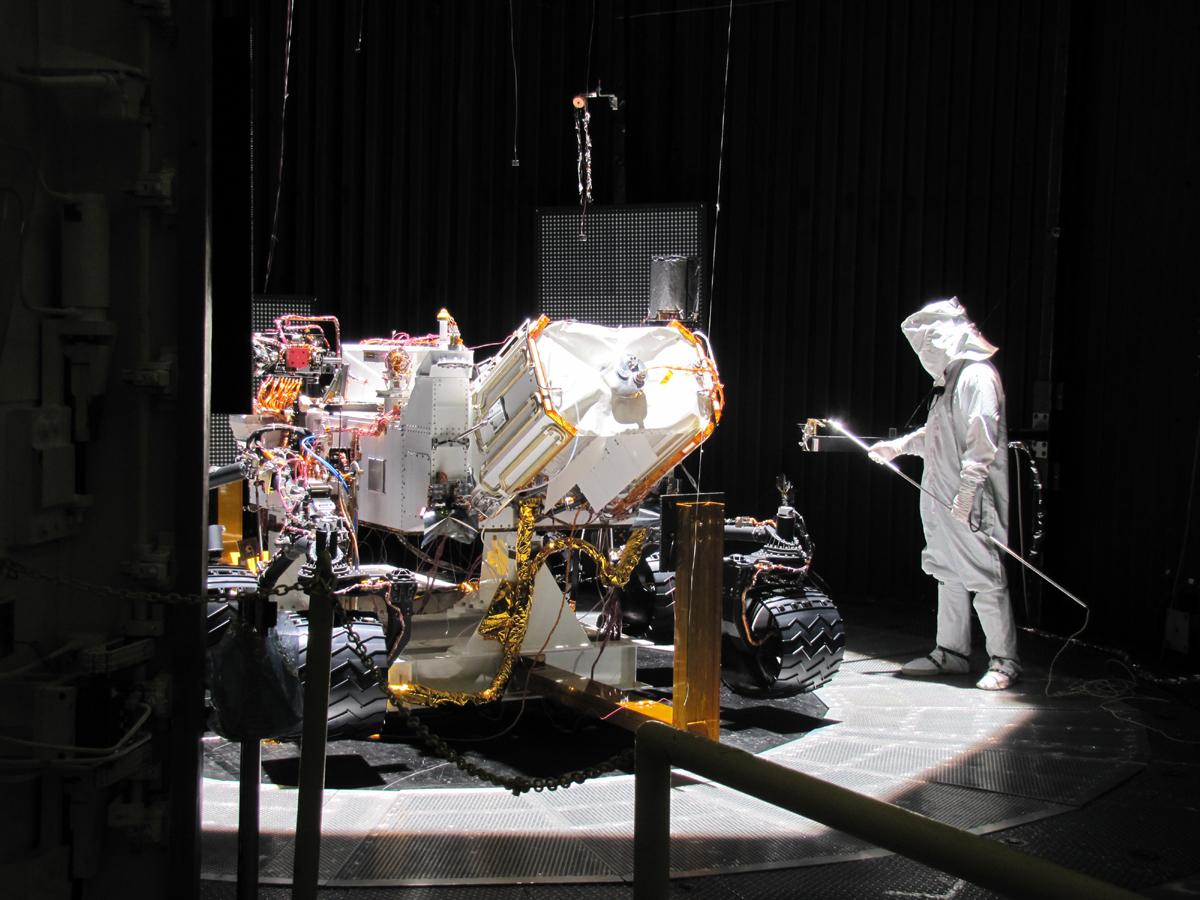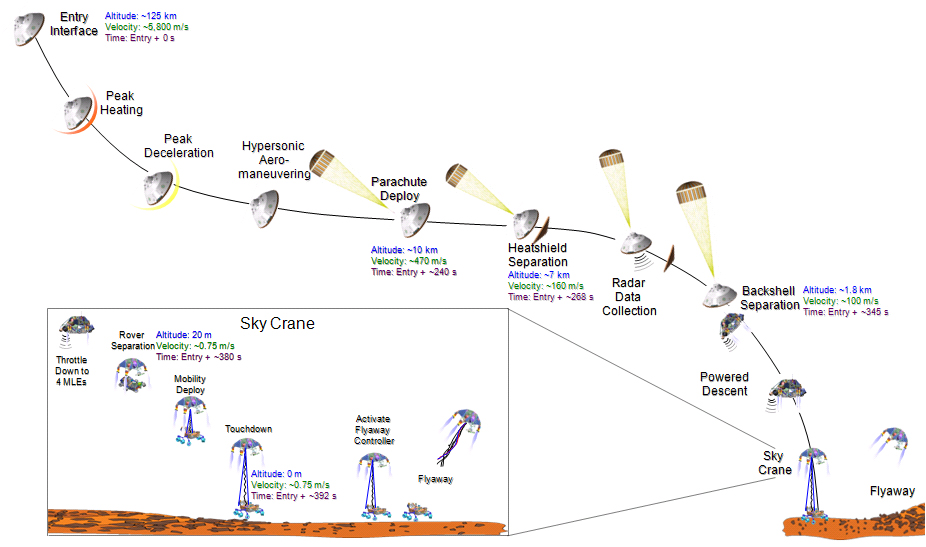NASA Examines Top Martian Landing Spots for Next Mars Rover

THE WOODLANDS, Texas — NASA is close to deciding on a landing site for its Mars rover Curiosity, a nuclear-powered mega-robot designed to reconnoiter the Red Planet as never before.
Curiosity is being readied for its sendoff to Mars later this year. The rover’s task will be to prowl around for environmental conditions favorable for microbial life and to collect evidence about whether Martian life ever existed.
A landing site status report on the nearly $2.5 billion Mars Science Laboratory Curiosity (MSL) project — classified with NASA's most ambitious "flagship" planetary missions — was given here during the 42nd Lunar and Planetary Science Conference (LPSC) March 7-11. Some 1,800 space scientists attended the meeting, organized by the Lunar and Planetary Institute and NASA's Johnson Space Center.
Down and dirty
Loaded with scientific gear, Curiosity is built to have a minimum driving range of 12 miles (20 kilometers), but likely can travel much farther over the course of its prime mission of one Martian year (two Earth years). [Best (and Worst) Mars Landings of All Time]

But getting down and dirty on Mars first means use of a unique entry, descent and landing system. No landing bags this go-around. Rather, a "Sky Crane" is to lower the rover on cables, placing it directly onto the planet's surface.
Four sites are under consideration for landing the Mars Science Laboratory, culled from more than 50 candidates that have been reviewed during the past four years. The scientists engaged in picking these top sites said they represent compelling locations where Curiosity can significantly advance knowledge regarding the conditions and potential habitability of Mars.
Get the Space.com Newsletter
Breaking space news, the latest updates on rocket launches, skywatching events and more!
"Preliminary landing simulation results indicate that all four of the landing sites are safe, so it does not look like landing safety will be the main discriminator," said Matthew Golombek, senior research scientist and Mars Exploration Program landing site scientist at NASA's Jet Propulsion Laboratory in Pasadena, Calif. Part of the reason for this is that the rover/Sky Crane system is "slope compliant," he told SPACE.com, meaning that it can easily land on sloped Martian terrain.
Golombek said analysis is ongoing regarding MSL's ability to traverse the Martian landscape, to distinguish, for example, how long the rover will take to get to the edge of a landing ellipse and then roll onward to specific targets of interest. The results of that work should be presented at the upcoming — and final — landing site workshop in mid-May, he said.[Video: Building Curiosity: NASA's Next Mars Rover]
Go-to spots on Mars

"The landing site [selection] process has been going on for quite some time," Golombek said here at the LPSC meeting. A landing spot's attractiveness is driven by both the hunger for good science, he said, and getting the Mars machinery down safe and sound.
Safety is the watchword. On the one hand, smooth areas relatively free of deep dust and large rocks are optimal. On the other hand, such landing zones, almost by definition, are fairly dull scientifically.
Given MSL's precision-landing skills, the footprint for a targeted spit of Mars landscape is small. That being the case, NASA can aim to land Curiosity in relatively boring sites that border on more interesting spots. In the case of three of the four possible landing zones, the area where the rover would touch down is not of particular interest, Golombek said, "but it's right next to something that we're very interested in."
Being nuclear-powered, Curiosity cannot go to a location that has either water or ice within one meter of the surface, Golombek noted, due to planetary protection guidelines.
The four cross-haired Curiosity landing zones are: Holden crater, Gale crater, Mawrth Vallis and Eberswalde crater. Each area has already undergone intensive scrutiny, with NASA's Mars Reconnaissance Orbiter, currently circling the Red Planet, playing a key role in charting each potential landing scene.
High science targets
According to JPL's Golombek, all four remaining sites clearly possess high science merit and were deemed to be generally safe and welcoming to Curiosity's initial wheels-down rest stop.
Those sites are:
- Eberswalde crater:contains a delta with phyllosilicates — clay-like minerals that preserve a record of long-term contact with water — thus, a potentially habitable environment that is particularly favorable to the preservation of organic materials.
- Holden crater:contains finely layered phyllosilicates that are deposited in a standing body of water thought to be a lake.
- Mawrth Vallis:exposes an ancient preserved layered stratigraphic section of terrain that provides an opportunity to characterize early wetter conditions back to roughly the first billion years of Mars history, known as the Noachian era.
- Gale crater:offers access to diverse rock strata, including interbedded sulfates and phyllosilicates in a mound three miles (5 kilometers) high that reflects deposition during changing environmental conditions.
Meanwhile, last-minute checkouts of Curiosity are under way. The countdown clock is ticking, with the launch window for MSL extending from Nov. 25 to Dec. 18, 2011.
Once the output from the forthcoming May landing site meeting is in hand, a three-day independent review will take place. "That will all be wrapped up and brought forward to NASA headquarters, which will make the [final site] selection probably in the June-July time frame," Golombek reported.
Leonard David has been reporting on the space industry for more than five decades. He is past editor-in-chief of the National Space Society's Ad Astra and Space World magazines and has written for SPACE.com since 1999.
Join our Space Forums to keep talking space on the latest missions, night sky and more! And if you have a news tip, correction or comment, let us know at: community@space.com.

Leonard David is an award-winning space journalist who has been reporting on space activities for more than 50 years. Currently writing as Space.com's Space Insider Columnist among his other projects, Leonard has authored numerous books on space exploration, Mars missions and more, with his latest being "Moon Rush: The New Space Race" published in 2019 by National Geographic. He also wrote "Mars: Our Future on the Red Planet" released in 2016 by National Geographic. Leonard has served as a correspondent for SpaceNews, Scientific American and Aerospace America for the AIAA. He has received many awards, including the first Ordway Award for Sustained Excellence in Spaceflight History in 2015 at the AAS Wernher von Braun Memorial Symposium. You can find out Leonard's latest project at his website and on Twitter.









